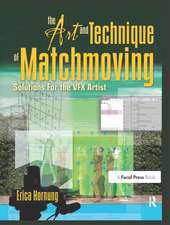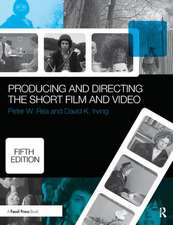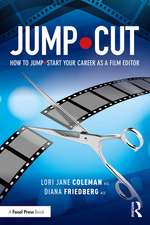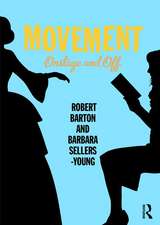The Media Workflow Puzzle: How It All Fits Together
Editat de Clyde Smith, Chris Lennonen Limba Engleză Hardback – 18 mar 2021
The Media Workflow Puzzle gives readers an in-depth overview of the workflow process, from production to distribution to archiving. Pulling from the expertise of twenty contributing authors and editors, the book covers topics including content production, postproduction systems, media asset management, content distribution, and archiving and preservation, offering the reader an understanding of all the various elements and processes that go into the media workflow ecosystem. It concludes with an exploration of the possibilities for the future of media workflows and the new opportunities it may bring.
Professionals and students alike looking to understand how to manage media content for its entire lifecycle will find this an invaluable resource.
| Toate formatele și edițiile | Preț | Express |
|---|---|---|
| Paperback (1) | 401.02 lei 6-8 săpt. | |
| Taylor & Francis – 18 mar 2021 | 401.02 lei 6-8 săpt. | |
| Hardback (1) | 767.64 lei 6-8 săpt. | |
| Taylor & Francis – 18 mar 2021 | 767.64 lei 6-8 săpt. |
Preț: 767.64 lei
Preț vechi: 1029.43 lei
-25% Nou
Puncte Express: 1151
Preț estimativ în valută:
146.91€ • 152.81$ • 121.28£
146.91€ • 152.81$ • 121.28£
Carte tipărită la comandă
Livrare economică 14-28 aprilie
Preluare comenzi: 021 569.72.76
Specificații
ISBN-13: 9780815392897
ISBN-10: 0815392893
Pagini: 272
Ilustrații: 35 Line drawings, black and white; 9 Halftones, black and white; 1 Tables, black and white
Dimensiuni: 178 x 254 mm
Greutate: 0.64 kg
Ediția:1
Editura: Taylor & Francis
Colecția Routledge
Locul publicării:Oxford, United Kingdom
ISBN-10: 0815392893
Pagini: 272
Ilustrații: 35 Line drawings, black and white; 9 Halftones, black and white; 1 Tables, black and white
Dimensiuni: 178 x 254 mm
Greutate: 0.64 kg
Ediția:1
Editura: Taylor & Francis
Colecția Routledge
Locul publicării:Oxford, United Kingdom
Public țintă
Professional and Professional Practice & DevelopmentCuprins
Contents
Introduction
Acknowledgements
Introduction
Overview
Revolution #1 – Television Enters the Scene
Revolution #2 – We Go Digital and Files Replace Physical Media
Revolution #3 – Multiplatform Distribution
Revolution #4 – Things Get Cloudy
Production
Cameras
The Types of Cameras and Their Uses
The Basics of Digital Cameras
The Implications of Camera Imaging Sensor Choice on System Requirements
The Various Forms of Color Coding & Color Spaces
What Does Gamma and Log Processing Mean?
What RAW Means and How to Digitally Process It
Compressed File Systems
Uncompressed File Systems
Common Camera Media Types
Common File Formats for Cameras
Common Production Formats
What Ingest Means and How to Organize It
Asset Management
On-set Grading
Dailies
Sources and Types of Metadata
The Role of the DIT
The Role of the Data Wrangler
eXtensible Markup Language (XML)
Key XML Terminology
Cloud Impacts
Post-Production
Introduction
Post-Production in Detail
Preparation
Technical Preparation
Post-Production Specific for TV
The End Game!
Dailies in More Depth
Editorial
Different Editorial Groups
Visual Effects (VFX)
VFX in Pre-Production
VFX in Production
VFX in Post-Production
Sound
Sound Editorial
Mixing
Predubs
Soundtrack Versions
Audio Loudness for TV and the Home
Digital Intermediate
Conforming
Image Fixing
Finishing
Color Pre-Timing and Reference Look
Mastering and Versioning Preparation
Mastering and Versioning
Mastering and Versioning Applied to TV Documentary
Titling, Captions, Subtitles, and Alternate Takes
Title Sequences
Captioning and Subtitling
Alternate Takes
Quality Control (QC)
QC for Theatrical Delivery
QC for Television
Compliance QC for Television Delivery
Content QC
Area for TV Immersive Audio QC
QC Database of QC Items
Photosensitive Epilepsy (PSE)
Sound Audibility for Television
Archive
The Future of Post-Production
Bonus Content
Special Section 1: Color Pipeline
Special Section 2: High Dynamic Range
Special Section 3: Visual Effects
Managing Your Media Assets and Workflows
Content Identification and its own metadata
Advertising
Content Identification for Programs
Business Systems
DAM/MAM Systems
Programming Workflow
Media Planning and Promotion in Linear Network and Broadcast Television
Sales/Traffic/Scheduling
Master Control Automation / Playback
How BXF Can Help
Quality Control
Annex A: Classification of QC checks
The Interoperable Master Format
Implications of IMF for Asset Management and Workflows
The Business Case for IMF
Automating Workflows
Cloud Impacts
Distribution to the Viewer
History and Evolution of Broadcast Networks and Stations
Modern Broadcast Networks and Stations
History and Evolution of Cable Systems and Cable Channels
Traditional Cable Systems and Cable Channels
History and Evolution of Satellite Television
Modern Satellite Television Systems
History and Evolution of Internet Video and OTT Services
Modern Internet Video and OTT Services
Modern Cable Systems
History and Evolution of Pre-Recorded Media
History and Evolution of Digital Cinema
Modern Digital Cinema Workflows
Mastering
Picture
Stereo Picture
Captions and Subtitles
Auxiliary Data
Other Unique Formats
Creating the Digital Cinema Package (DCP)
MXF Wrapping and Encryption
Composition Play List (CPL)
Asset Map, Volume Index, and Packing List
Key Delivery Message (KDM)
Transport
Theater Storage and Projection
Theater Management Systems (TMS)
Showtime Projection
Projector Types
Summary – The Impact of Distribution Systems on Production Workflows
Wrapup – Content Delivery to Multiple Distribution Systems
Archive and Preservation
Introduction
Why Digital Archive
Creation
Consumption
Archive
Libraries, Repositories, and Archives
Digital Library
Digital Repository and Digital Archive
Preservation
Library and Archive Science
Forever Is a Long Time
What Is an Asset?
Asset Value
The Asset Construct
Technical Metadata
Connecting Metadata and Essence
Data Scale
Enterprise and Broadcast Technology Collide
Backup
Hierarchical Storage Management (HSM)
Content Storage Management (CSM) and Active Archive
Software Defined Archive (SDA)
Build Versus Buy
Storage Technology
Solid State
Hard Drives
Optical Disc
Data Tape
Public Cloud Services
Future Technologies
Storage Classifications
Tier 0 Storage
Tier 1 Storage
Tier 2 Storage
Tier 3 Storage
Tier 4 Storage
Storage Tier Summary
The Anatomy of a Digital Archive
Storage Abstraction
Storage Orchestration
Archive Maintenance
Asset Integrity
Connecting the Bits and Pieces
Archive Transformation and Modernization
Standards-Based Digital Asset Protection
Archive eXchange Format (AXF)
Standard
A Closer Look
AXF Structures
Inside an AXF Object
History of AXF
Conclusion
Looking Ahead
Looking Deep into the Future: Al Kovalick
The Granddaddy of Exponential Laws in Electronics
The Power of the Exponential
The Evolution of Infrastructure Elements
Software Powers Media Workflows
Networking Capability and Performance
Infrastructure Rides the Exponential
The Analog and Digital S-Curves
The COTS/IP S-Curve
The SDMI S-Curve
The Public Cloud S-Curve
Contemporaneous S-Curves
Final Words
The Future Is Real
The Future is Real
Glossary of Terms
Index
Introduction
Acknowledgements
Introduction
Overview
Revolution #1 – Television Enters the Scene
Revolution #2 – We Go Digital and Files Replace Physical Media
Revolution #3 – Multiplatform Distribution
Revolution #4 – Things Get Cloudy
Production
Cameras
The Types of Cameras and Their Uses
The Basics of Digital Cameras
The Implications of Camera Imaging Sensor Choice on System Requirements
The Various Forms of Color Coding & Color Spaces
What Does Gamma and Log Processing Mean?
What RAW Means and How to Digitally Process It
Compressed File Systems
Uncompressed File Systems
Common Camera Media Types
Common File Formats for Cameras
Common Production Formats
What Ingest Means and How to Organize It
Asset Management
On-set Grading
Dailies
Sources and Types of Metadata
The Role of the DIT
The Role of the Data Wrangler
eXtensible Markup Language (XML)
Key XML Terminology
Cloud Impacts
Post-Production
Introduction
Post-Production in Detail
Preparation
Technical Preparation
Post-Production Specific for TV
The End Game!
Dailies in More Depth
Editorial
Different Editorial Groups
Visual Effects (VFX)
VFX in Pre-Production
VFX in Production
VFX in Post-Production
Sound
Sound Editorial
Mixing
Predubs
Soundtrack Versions
Audio Loudness for TV and the Home
Digital Intermediate
Conforming
Image Fixing
Finishing
Color Pre-Timing and Reference Look
Mastering and Versioning Preparation
Mastering and Versioning
Mastering and Versioning Applied to TV Documentary
Titling, Captions, Subtitles, and Alternate Takes
Title Sequences
Captioning and Subtitling
Alternate Takes
Quality Control (QC)
QC for Theatrical Delivery
QC for Television
Compliance QC for Television Delivery
Content QC
Area for TV Immersive Audio QC
QC Database of QC Items
Photosensitive Epilepsy (PSE)
Sound Audibility for Television
Archive
The Future of Post-Production
Bonus Content
Special Section 1: Color Pipeline
Special Section 2: High Dynamic Range
Special Section 3: Visual Effects
Managing Your Media Assets and Workflows
Content Identification and its own metadata
Advertising
Content Identification for Programs
Business Systems
DAM/MAM Systems
Programming Workflow
Media Planning and Promotion in Linear Network and Broadcast Television
Sales/Traffic/Scheduling
Master Control Automation / Playback
How BXF Can Help
Quality Control
Annex A: Classification of QC checks
The Interoperable Master Format
Implications of IMF for Asset Management and Workflows
The Business Case for IMF
Automating Workflows
Cloud Impacts
Distribution to the Viewer
History and Evolution of Broadcast Networks and Stations
Modern Broadcast Networks and Stations
History and Evolution of Cable Systems and Cable Channels
Traditional Cable Systems and Cable Channels
History and Evolution of Satellite Television
Modern Satellite Television Systems
History and Evolution of Internet Video and OTT Services
Modern Internet Video and OTT Services
Modern Cable Systems
History and Evolution of Pre-Recorded Media
History and Evolution of Digital Cinema
Modern Digital Cinema Workflows
Mastering
Picture
Stereo Picture
Captions and Subtitles
Auxiliary Data
Other Unique Formats
Creating the Digital Cinema Package (DCP)
MXF Wrapping and Encryption
Composition Play List (CPL)
Asset Map, Volume Index, and Packing List
Key Delivery Message (KDM)
Transport
Theater Storage and Projection
Theater Management Systems (TMS)
Showtime Projection
Projector Types
Summary – The Impact of Distribution Systems on Production Workflows
Wrapup – Content Delivery to Multiple Distribution Systems
Archive and Preservation
Introduction
Why Digital Archive
Creation
Consumption
Archive
Libraries, Repositories, and Archives
Digital Library
Digital Repository and Digital Archive
Preservation
Library and Archive Science
Forever Is a Long Time
What Is an Asset?
Asset Value
The Asset Construct
Technical Metadata
Connecting Metadata and Essence
Data Scale
Enterprise and Broadcast Technology Collide
Backup
Hierarchical Storage Management (HSM)
Content Storage Management (CSM) and Active Archive
Software Defined Archive (SDA)
Build Versus Buy
Storage Technology
Solid State
Hard Drives
Optical Disc
Data Tape
Public Cloud Services
Future Technologies
Storage Classifications
Tier 0 Storage
Tier 1 Storage
Tier 2 Storage
Tier 3 Storage
Tier 4 Storage
Storage Tier Summary
The Anatomy of a Digital Archive
Storage Abstraction
Storage Orchestration
Archive Maintenance
Asset Integrity
Connecting the Bits and Pieces
Archive Transformation and Modernization
Standards-Based Digital Asset Protection
Archive eXchange Format (AXF)
Standard
A Closer Look
AXF Structures
Inside an AXF Object
History of AXF
Conclusion
Looking Ahead
Looking Deep into the Future: Al Kovalick
The Granddaddy of Exponential Laws in Electronics
The Power of the Exponential
The Evolution of Infrastructure Elements
Software Powers Media Workflows
Networking Capability and Performance
Infrastructure Rides the Exponential
The Analog and Digital S-Curves
The COTS/IP S-Curve
The SDMI S-Curve
The Public Cloud S-Curve
Contemporaneous S-Curves
Final Words
The Future Is Real
The Future is Real
Glossary of Terms
Index
Recenzii
Endorsements
This a 4-year college class and 10-year internship rolled into one! -Mark Seigle, Industry Executive
This is an absolute must read and a necessary resource for any media executive, educator or student wanting to have a comprehensive understanding of the myriad of descriptions, issues and impacts on a variety of technical elements and management perspectives focusing on the workflow involved in the production, post-production, distribution, asset management and archiving of media content. What Chris Lennon and Clyde Smith (two of the most knowledgeable experts in the world on this topic) have done here in their book is to put all of these pieces of the media workflow puzzle together in one place, providing a most intriguing assembly of topics and knowledge that covers this rapidly evolving terrain with tremendous insight and clarity. -Dr. Corey P. Carbonara, Professor, Department of Film and Digital Media, Baylor University
Media Workflow is a complex and nuanced area. Chris Lennon and Clyde Smith have compiled a deep look at the component parts of this area and give the reader tremendous context into how the pieces fit together with brilliant business context. - Harold S Geller, Executive Director, Ad-ID LLC.
A great overview of workflows in the media industry. Gives a comprehensive, high-level overview of media processes from "glass-to-glass"." Chris and Clyde have done a great job of collecting and presenting material from many subject-matter experts in our industry. I would recommend this book for students, for Executives who are unfamiliar with media workflows, and for anyone who is looking for a "big picture" view of the media industry. -Brad Gilmer, Executive Director, AMWA
This book provides an all-inclusive, great foundation about how and why TV and Film technologies got this point, how they operate, where they come together, and it also provides a good look to where the industry may be headed in the future. This is a great read for college students, people entering the media business and for those people like me who are working in the Entertainment Business. -Tom Kline, Sr. Director of Program Standards, a major U.S. network
Nothing else in this world compares to electronic media workflow. The machinery, tools and processes are constantly evolving and the capabilities constantly increasing. This book follows the evolution from those simple signal flows to virtualization and abstraction. There are plenty of takeaways. Plenty of, "so this is why we do it this way" moments. I think fortunately, for our own enjoyment of electronic media entertainment and education, we all fail to properly appreciate workflow as a result of overfamiliarity. At least for the time one is reading this book we can admire the elegance and enchanting mechanisms that step-after-step make up what we all, even us workflow wonks, take for granted. It’s a good read. It makes you stop and think "What if we did this differently?" The creative part of electronic media isn’t just the content -- this book captures that - Fred Baumgartner, Director NextGen TV Implementation, ONEMedia 3.0 / Sinclair Broadcasting
A "must read" for both experts and non-experts in both cinema and TV technology - Pierre Maillat, Canal Plus
"This a 4-year college class and 10-year internship rolled into one!"
Mark Seigle, Industry Executive
"This is an absolute must-read and a necessary resource for any media executive, educator, or student wanting to have a comprehensive understanding of the myriad of descriptions, issues, and impacts on a variety of technical elements and management perspectives focusing on the workflow involved in the production, post-production, distribution, asset management, and archiving of media content. What Chris Lennon and Clyde Smith (two of the most knowledgeable experts in the world on this topic) have done here in their book is to put all of these pieces of the media workflow puzzle together in one place, providing a most intriguing assembly of topics and knowledge that covers this rapidly evolving terrain with tremendous insight and clarity.
Dr. Corey P. Carbonara, Professor, Department of Film and Digital Media, Baylor University
"Media Workflow is a complex and nuanced area. Chris Lennon and Clyde Smith have compiled a deep look at the component parts of this area and give the reader tremendous context into how the pieces fit together with brilliant business context."
Harold S. Geller, Executive Director, Ad-ID LLC.
"A great overview of workflows in the media industry. Gives a
great foundation about how and why TV and film technologies got this point, how they operate, where they come together, and it also provides a good look at where the industry may be headed in the future. This is a great read for college students, people entering the media business, and for those people like me who are working in the entertainment business.
Tom Kline, Sr. Director of Program Standards, a major US network
"Nothing else in this world compares to electronic media workflow. The machinery, tools, and processes are constantly evolving and the capabilities constantly increasing. This book follows the evolution from those simple signal flows to virtualization and abstraction. There are plenty of takeaways. Plenty of, 'so this is why we do it this way' moments. I think fortunately, for our own enjoyment of electronic media entertainment and education, we all fail to properly appreciate workflow as a result of overfamiliarity. At least for the time one is reading this book we can admire the elegance and enchanting mechanisms that step-after-step make up what we all, even us workflow wonks, take for granted. It’s a good read. It makes you stop and think 'What if we did this differently?' The creative part of electronic media isn’t just the content – this book captures that. Fred Baumgartner, Director NextGen TV Implementation, ONEMedia 3.0 / Sinclair Broadcasting
"A 'must read' for both experts and non-experts in both cinema and TV technology."
Pierre Maillat, Canal Plus
experts and non-experts in both cinema and TV technology - Pierre Maillat, Canal Plus
This a 4-year college class and 10-year internship rolled into one! -Mark Seigle, Industry Executive
This is an absolute must read and a necessary resource for any media executive, educator or student wanting to have a comprehensive understanding of the myriad of descriptions, issues and impacts on a variety of technical elements and management perspectives focusing on the workflow involved in the production, post-production, distribution, asset management and archiving of media content. What Chris Lennon and Clyde Smith (two of the most knowledgeable experts in the world on this topic) have done here in their book is to put all of these pieces of the media workflow puzzle together in one place, providing a most intriguing assembly of topics and knowledge that covers this rapidly evolving terrain with tremendous insight and clarity. -Dr. Corey P. Carbonara, Professor, Department of Film and Digital Media, Baylor University
Media Workflow is a complex and nuanced area. Chris Lennon and Clyde Smith have compiled a deep look at the component parts of this area and give the reader tremendous context into how the pieces fit together with brilliant business context. - Harold S Geller, Executive Director, Ad-ID LLC.
A great overview of workflows in the media industry. Gives a comprehensive, high-level overview of media processes from "glass-to-glass"." Chris and Clyde have done a great job of collecting and presenting material from many subject-matter experts in our industry. I would recommend this book for students, for Executives who are unfamiliar with media workflows, and for anyone who is looking for a "big picture" view of the media industry. -Brad Gilmer, Executive Director, AMWA
This book provides an all-inclusive, great foundation about how and why TV and Film technologies got this point, how they operate, where they come together, and it also provides a good look to where the industry may be headed in the future. This is a great read for college students, people entering the media business and for those people like me who are working in the Entertainment Business. -Tom Kline, Sr. Director of Program Standards, a major U.S. network
Nothing else in this world compares to electronic media workflow. The machinery, tools and processes are constantly evolving and the capabilities constantly increasing. This book follows the evolution from those simple signal flows to virtualization and abstraction. There are plenty of takeaways. Plenty of, "so this is why we do it this way" moments. I think fortunately, for our own enjoyment of electronic media entertainment and education, we all fail to properly appreciate workflow as a result of overfamiliarity. At least for the time one is reading this book we can admire the elegance and enchanting mechanisms that step-after-step make up what we all, even us workflow wonks, take for granted. It’s a good read. It makes you stop and think "What if we did this differently?" The creative part of electronic media isn’t just the content -- this book captures that - Fred Baumgartner, Director NextGen TV Implementation, ONEMedia 3.0 / Sinclair Broadcasting
A "must read" for both experts and non-experts in both cinema and TV technology - Pierre Maillat, Canal Plus
"This a 4-year college class and 10-year internship rolled into one!"
Mark Seigle, Industry Executive
"This is an absolute must-read and a necessary resource for any media executive, educator, or student wanting to have a comprehensive understanding of the myriad of descriptions, issues, and impacts on a variety of technical elements and management perspectives focusing on the workflow involved in the production, post-production, distribution, asset management, and archiving of media content. What Chris Lennon and Clyde Smith (two of the most knowledgeable experts in the world on this topic) have done here in their book is to put all of these pieces of the media workflow puzzle together in one place, providing a most intriguing assembly of topics and knowledge that covers this rapidly evolving terrain with tremendous insight and clarity.
Dr. Corey P. Carbonara, Professor, Department of Film and Digital Media, Baylor University
"Media Workflow is a complex and nuanced area. Chris Lennon and Clyde Smith have compiled a deep look at the component parts of this area and give the reader tremendous context into how the pieces fit together with brilliant business context."
Harold S. Geller, Executive Director, Ad-ID LLC.
"A great overview of workflows in the media industry. Gives a
great foundation about how and why TV and film technologies got this point, how they operate, where they come together, and it also provides a good look at where the industry may be headed in the future. This is a great read for college students, people entering the media business, and for those people like me who are working in the entertainment business.
Tom Kline, Sr. Director of Program Standards, a major US network
"Nothing else in this world compares to electronic media workflow. The machinery, tools, and processes are constantly evolving and the capabilities constantly increasing. This book follows the evolution from those simple signal flows to virtualization and abstraction. There are plenty of takeaways. Plenty of, 'so this is why we do it this way' moments. I think fortunately, for our own enjoyment of electronic media entertainment and education, we all fail to properly appreciate workflow as a result of overfamiliarity. At least for the time one is reading this book we can admire the elegance and enchanting mechanisms that step-after-step make up what we all, even us workflow wonks, take for granted. It’s a good read. It makes you stop and think 'What if we did this differently?' The creative part of electronic media isn’t just the content – this book captures that. Fred Baumgartner, Director NextGen TV Implementation, ONEMedia 3.0 / Sinclair Broadcasting
"A 'must read' for both experts and non-experts in both cinema and TV technology."
Pierre Maillat, Canal Plus
experts and non-experts in both cinema and TV technology - Pierre Maillat, Canal Plus
Descriere
This edited collection brings together a team of top industry experts to provide a comprehensive look at the entire media workflow from start to finish.

















